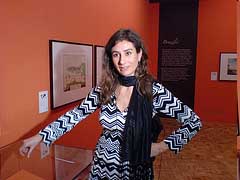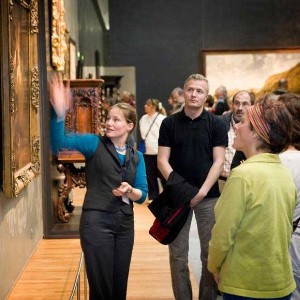Visual Arts: New Year’s Resolutions and On Augmenting Art
In practical terms the Virtual Reality helmet has still not lived up to its potential. Another device has come along, however, that can convey as much information, though without the total visual immersion of Virtual Reality. This is nothing other than the humble cell phone . . .
By Gary Schwartz.

The Art Historian -- Introducing the head of our department of history. If you have studied art history or want to hear about the latest scholarly discoveries about our objects, listen to what she has to tell.
In 1997 I was asked by The Art Bulletin, a leading scholarly journal, to write a contribution for a special section on “Digital culture and the practices of art and art history.” In my essay, “Digital imagery and user-defined art” (The Art Bulletin, vol. 79, nr. 2, June 1997, pp. 206–08), I pondered the effects on art history of the increased control over images of art works being put in the hands of users. If images can be tweaked to suit the taste of anyone with a digital device, how can a museum exercise its responsibility to show its holdings as it feels they should be seen? My answer was that the museum should use its strongest suit—possession of original objects—in combination with digital media.
The trump trick I am contemplating would [make] direct experience of the original an indispensable element for appreciating digital enhancement at its best. In this regard, another form of interactivity is a more appropriate model than the CD-ROM or the Web site. That is, the free-route audio tours one can now use in certain exhibitions or collections. While looking at the original, the visitor can access one or more kinds of commentary to enrich (or at least amplify) the visual experience. In the scenario I am contemplating, the museum will augment such spoken information with personalized visual enhancements to its displays. Now that we have grown accustomed to looking silly walking around with audio head-sets, we have been made ripe for virtual-reality helmets. Whether or not present-day VR can do the trick I do not know. But I do know what I would like to see with it. Let me take the National Gallery in London as an example. While looking at the Duccio Annunciation panel, I would like the helmet to show me, in a realistic but differentiable virtual projection, how scholars think it fits into the predella of the Maestà and how the Maestà looked on the high altar of the Sienese Duomo before it was removed shortly after 1500.
I went on from there to sketch the ways in which a museum could combine direct viewing with digital enhancements. What I did not know was that seven years earlier the Boeing physicist Thomas Caudell had coined the term “augmented reality” for experiences of just that kind, and that articles had been written about it in journals I never get to see, such as IEICE Transactions on Information and Systems. The First International Workshop on Augmented Reality, a yearly event since, was not held until November 1998 in San Francisco. Had I known about it, I would have attended, and my plan might have been put into development.

The Docent — No one knows better what interests the general visitor than our own docents, who have been taking the public around the museum for years. You will surely enjoy your personal docent's enthusiastic and well-informed remarks.
In practical terms the VR helmet has still not lived up to its potential. Another device has come along, however, that can convey as much information, though without the total visual immersion of VR. This is nothing other than the humble cell phone with camera that all of us carry around and of which we have three or four discarded models in a drawer. Earlier this year I caught onto a new possibility in the making. Point the camera of your cell phone—or tablet or something in between—at a museum display and be treated to a custom show about it, tailored to your interests and level, on the screen and earphones of your device.
With a Dutch developer, I worked out a proposal, which we pitched to a big art museum. For a while it looked like we were on track toward agreement on a pilot project, but the museum pulled out of the talks before the plan was even seriously discussed.
For The Art Bulletin I described an application for art historians. In the current situation, I expanded the plan to include the general museum visitor as well. The visitor would be offered a choice between presentations by a docent, an art-historical curator, a conservationist, and an artist.
It would take a lot of work to stock the database, but much of the information is already on file. The filmed introductions of the Personal Curator and the presentation of additional images would segue in a short while into voice only, bringing the viewer closer to the work itself. I envisioned a future in which schoolchildren would fight over the nicest tablet and would come to the museum in order to enjoy a lively interactivity with the collection.
As much as I would like to bring a project like this into being, in a draft New Year’s resolution that I publicized on New Year’s Eve, I have decided not to pursue the project further on my own initiative. It is simply too risky to invest in a project like this without the commitment of a museum partner. There is a lot of action in art applications for the cell phone and a lot of competition. If anyone out there is interested in the ideas I framed in 1997 and my proposal of 2010, they now know how to find me.
Another of my resolutions is to concentrate on the multitude of smaller studies on which I have worked for the past years without finishing them.
Bit by bit I am getting there. In 2010, beside Schwartzlist columns 301–10, I have published these three articles, all based on older research:
“Love in the huiskamer,” Desipientia 18 (2010), nr. 2, pp. 45–27
“J. van Beecq, Amsterdam marine painter, ‘the only one here [in France] who excels in this genre,’” in Les échanges artistiques entre les anciens Pay-Bas et la France, 1482-1814, ed. Gaëtane Maës and Jan Blanc, Turnhout (Brepols) 2010, pp. 15–32
“The Barberini and Orange inventories: a comparison of the collections and their publication,” Medieval, Renaissance, Baroque: a cat’s cradle for Marilyn Aronberg Lavin, ed. David A. Levine and Jack Freiberg, New York (Italica Press) 2010, pp. 167–78
A third New Year’s resolution is to put up more of my writings on internet. That out of gratitude for your attention. I wish all readers of the Schwartzlist a healthy and fulfilling new year.
An Information Age message in a bottle: from Thursday evening, 23 December, 21:30 through Tuesday afternoon, 28 December, 13:45, my e-mail account at xs4all, through an error of the provider’s, seems to have been completely disbanded. Mails addressed to me were returned with the error message “User not known.” Anyone who sent me a mail in that period is kindly requested to resend it.
===============================================================
© Gary Schwartz 2010. Published on the Schwartzlist on December 31, 2010. With thanks to the Prince Bernhard Cultural Foundation for helping, through its Prize for the Humanities, to fund Schwartzlist columns, and to Jeroen Meijer of MuzAR for inspiring discussions about augmented reality in museums.
Responses to Gary.Schwartz@xs4all.nl
Tagged: Gary-Schwartz, Schwartzlist, digital media, museum, virtual reality
